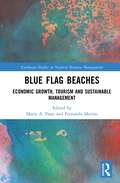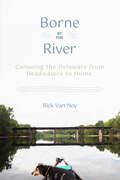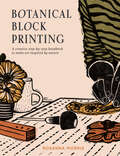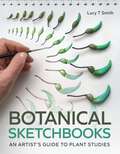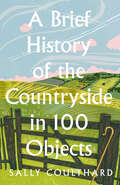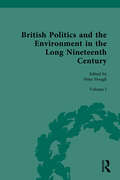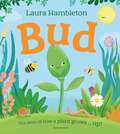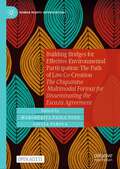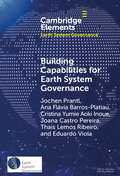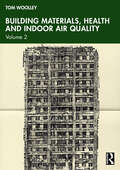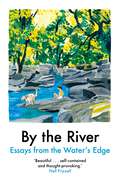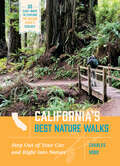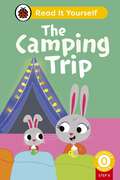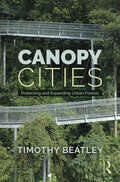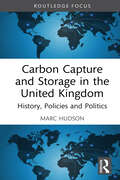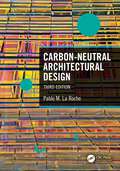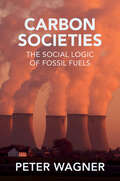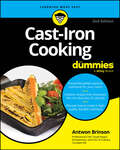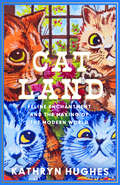- Table View
- List View
Blue Flag Beaches: Economic Growth, Tourism and Sustainable Management (Earthscan Studies in Natural Resource Management)
by María A. Prats Fernando MerinoThis book presents a comprehensive study of the role that the Blue Flag beach program has played around the world, considering economic, social and environmental perspectives. Since its creation in the 1980s, The Blue Flag program awards the management of beaches and marinas based on sustainability, services and quality of their management. To date there are currently close to five thousand awards around the world. Forty years on from the program's creation, this book provides a thorough evaluation of the program, to understand how it has evolved over time, the successes it has enjoyed and the challenges it has overcome, and may face in the future. As an international program, this book reflects the global nature of this program and actively discusses, examines and assesses the different realities and challenges faced by different countries around the world, drawing on case studies from across Europe, North America, Latin America, Africa and Asia. It examines the impact of the award on economic growth, from local to national, environmental protection and education, the development of sustainable tourism, and the sustainable management of beaches. The volume also contributes to emerging debates surrounding the certification of natural resources, where the Blue Flag program has been a pioneer in this field. This book will be of great interest to students and scholars of sustainable tourism, environmental economics, coastal and beach management, environmental conservation and sustainable development.
Borne by the River: Canoeing the Delaware from Headwaters to Home
by Rick Van NoyAfter a near-fatal stroke and a separation, amidst a global pandemic, Rick Van Noy decided to go for a paddle. In Borne by the River, he charts the story of discovery, and healing that came from this solo canoe journey. Paddling two hundred miles on the Delaware River to his boyhood home just upriver from Trenton, New Jersey, Van Noy contemplates his fate and life, as well as the simple joy of sitting in a small boat floating down a large river with his dog, Sully.Deftly combining memoir, natural and local history, and engaging reportage of his encounters with other paddlers and river enthusiasts, including members of the Lenape Nation of Pennsylvania, Van Noy reveals deep and shifting layers of environmental, historical, cultural, and personal significance of the Delaware. Borne by the River reckons with the way that rivers braid into one's own life—thrilling rapids, eddying pauses, and life-changing rifts and falls. Van Noy rediscovers and shares how river journeys can scatter anxieties, wash away regrets, and recreate the spirit in its free-flowing currents.
Botanical Block Printing: A Creative Step-by-step Handbook To Make Art Inspired By Nature
by Rosanna MorrisDiscover the world of botanical block printing through an approachable guide that unveils a plethora of practical techniques and processes. This guide invites you to create stunning prints inspired by the natural world, all crafted by your own hands.
Botanical Sketchbooks: An Artist's Guide to Plant Studies
by Lucy SmithThis inspirational guide explains how a botanical sketchbook can take many forms and hold different meanings. It shows how a sketchbook can be used as a workbook to study plants through drawing and painting in a variety of media. It includes examples of preliminary work for finished pieces, experiments in colour and exploration of plant anatomy, and shows how these studies can be made away from the pressure of creating the perfect, polished piece of final botanical artwork. It goes on to feature sketchbooks created for their own sake as a curated space for an artist to draw and record plants over a period of time, or a particular place.
A Brief History of the Countryside in 100 Objects
by Sally CoulthardThe untold story of rural Britain revealed through its artefacts
British Politics and the Environment in the Long Nineteenth Century: Volume I - Discovering Nature and Romanticizing Nature
by Peter HoughThis volume of archival source material chronicles British environmental politics between 1789 and 1914. This text examines scientific discoveries during this period and the result of these findings on the political environment, bringing the public's attention to public health issues such as acid rain and river pollution. Accompanied by extensive editorial commentary, this collection will be of great interest to students of environmental and political history.
British Politics and the Environment in the Long Nineteenth Century: Volume I - Discovering Nature and Romanticizing Nature
by Peter HoughThis volume of archival source material chronicles British environmental politics between 1789 and 1914. This text examines scientific discoveries during this period and the result of these findings on the political environment, bringing the public's attention to public health issues such as acid rain and river pollution. Accompanied by extensive editorial commentary, this collection will be of great interest to students of environmental and political history.
Bud: The story of how a plant grows ... up!
by Laura HambletonThis bright, fun and friendly non-fiction picture book about what happens when one plant grows (up) is a gentle introduction to plant life cycles for readers 3+.Meet Bud, a TINY rosebud on a BIG adventure. Sitting in a cosy greenhouse, in an even cosier red pot is Bud. Every day, Bud is warmed by Sun and told stories about the BIg Outside by Moon. Bud is happy and content until ... POP! Bud is planted beside looming trees and wiggly worms. The Big Outside is SCARY - but new adventures can be, and there's no bigger adventure than growing up. A reassuring growing-up story with facts about plants, this adorable book will inspire green fingers in little ones while preparing them for their own growing-up journey.
Building Bridges for Effective Environmental Participation: The Chiquitano Multimodal Format for Disseminating the Escazú Agreement (Human Rights Interventions)
by Margherita Paola Poto Giulia ParolaThis open-access book aims to explore and promote indigenous participation in legal design and visual law, with a specific focus on co-creating a visual representation of the Escazu Agreement in collaboration with the Chiquitano people. This project stands out as a unique and transformative endeavor, offering distinctive features and a range of benefits to its readers and stakeholders.
Building Capabilities for Earth System Governance (Elements in Earth System Governance)
by null Jochen Prantl null Ana Flávia Barros-Platiau null Cristina Yumie Inoue null Joana Castro Pereira null Thais Lemos Ribeiro null Eduardo ViolaThis Element develops a new Strategic Capabilities Framework for studying and steering complex socio-ecological systems. It is driven by the central question of what are the most essential capabilities that ought to be fostered for addressing the fundamental 21st Century environmental challenges and Earth system transformations. The author's objective is to innovate transformative ideas toward better climate and ocean governance that are of interest both to academics and policymakers in the field. Rather than investigating the design and effectiveness of institutions in governing the climate and the oceans, the authors offer an alternative approach starting from the assumption that global governance arrangements must be informed by the capabilities of the communities affected. This Element aims to offer out-of-the-box thinking about capabilities-focused and community-centered frameworks that align multi-level systems of governance with the fundamental challenges of global environmental change. This title is also available as Open Access on Cambridge Core.
Building Materials, Health and Indoor Air Quality: Volume 2
by Tom WoolleyIn Building Materials, Health and Indoor Air Quality: Volume 2 Tom Woolley uses new research to continue to advocate for limiting the use of hazardous materials in construction and raise awareness of the links between pollutants found in building materials, poor indoor air quality and health problems. Chapters in this volume reinforce previous arguments and present new ones covering: Further evidence of the health impacts of hazardous emissions from materials Hazardous materials to be avoided and why Fire and smoke toxicity – the Lakanal House and Grenfell Tower legacy Sub-standard retrofits leading to damp and mould in previously sound houses A critical review of recent reports from UK Government and others on air quality and health problems including policy changes on flame retardants Growing evidence of cancer risks and the failure of cancer research organisations to address these issues A critical review of recent climate change and zero carbon policies and a discussion on whether extreme energy efficiency is a good thing This book asks some important and, for some, uncomfortable questions, but in doing so it brings to light important areas for research and provides much needed guidance for architects, engineers, construction professionals, students and researchers on hazardous materials and how to reduce their use and design and build healthier buildings for all occupants.
Building Materials, Health and Indoor Air Quality: Volume 2
by Tom WoolleyIn Building Materials, Health and Indoor Air Quality: Volume 2 Tom Woolley uses new research to continue to advocate for limiting the use of hazardous materials in construction and raise awareness of the links between pollutants found in building materials, poor indoor air quality and health problems. Chapters in this volume reinforce previous arguments and present new ones covering: Further evidence of the health impacts of hazardous emissions from materials Hazardous materials to be avoided and why Fire and smoke toxicity – the Lakanal House and Grenfell Tower legacy Sub-standard retrofits leading to damp and mould in previously sound houses A critical review of recent reports from UK Government and others on air quality and health problems including policy changes on flame retardants Growing evidence of cancer risks and the failure of cancer research organisations to address these issues A critical review of recent climate change and zero carbon policies and a discussion on whether extreme energy efficiency is a good thing This book asks some important and, for some, uncomfortable questions, but in doing so it brings to light important areas for research and provides much needed guidance for architects, engineers, construction professionals, students and researchers on hazardous materials and how to reduce their use and design and build healthier buildings for all occupants.
By the River: Essays from the Water's Edge
by Various ContributorsMemory flows like a river, and it is through its constant flow that we come into being. Twelve of our most exciting contemporary writers consider the subject of rivers and how they shape us throughout our lives, demarcating cities as well as moulding our creative consciousness. Tessa Hadley revisits Rumer Godden's The River; Jo Hamya pays homage to Virginia Woolf; Michael Malay goes nightfishing for eels along the River Severn; Marchelle Farrell revisits the tropical waterfalls of her childhood home in Trinidad; and Caleb Azumah Nelson is drawn to the Guadalquivir in Seville. Tender and astute, By the River explores the cultural, social and psychological significance of the rivers that run through our societies and our minds, bringing together writers in a celebration of water and its transformative qualities.
California's Best Nature Walks: 32 Easy Ways to Explore the Golden State's Ecology
by Charles HoodExplore some of California&’s most exquisite landscapes with this accessible hiking guidebook featuring descriptions of the flora, fauna, and ecology hikers will discover along the trail. See the oldest trees in the world—and the tallest. Meet earthquake-loving fish, lively island foxes, and endemic birds. Visit the saltwater homes to sea otters and a desert basin where the water is even saltier. In California&’s Best Nature Walks, Charles Hood reveals the golden state&’s unique ecosystems, guiding you through 32 spectacular natural areas, with advice on deciphering the terrain. All are within easy walking distance of the road. This is an essential companion for road-trippers, outdoor enthusiasts, and day hikers—no cleated boots or trekking poles necessary. Locations include the Arcata Marsh and Wildlife Sanctuary, McConnell Arboretum and Botanical Gardens, Olmsted Point at Yosemite National Park, Fossil Falls, Camp Roberts Rest Area along Highway 101, Scorpion Anchorage at Channel Islands National Park, Vasquez Rocks Natural Area, and more!
The Camping Trip (Read It Yourself)
by LadybirdTwo stories that build on the phonics learned in previous steps and focus on the sound and letter combinations: igh, ear, air, ure.The Camping Trip is from Beginner Reader Level 0 and is ideal for children aged from 4+ who are developing their phonics and early reading skills.Each book has been carefully checked by educational and subject consultants and includes comprehension puzzles, book band information, and tips for helping children with their reading.With five levels to take children from first phonics to fluent reading and a wide range of different stories and topics for every interest, Read It Yourself helps children build their confidence and begin reading for pleasure.
Canopy Cities: Protecting and Expanding Urban Forests
by Timothy BeatleyThis book provides a comprehensive overview of the essential role of trees and forests in cities and examines the creative approaches cities around the world are taking to protect trees and expand their urban forests. Moving beyond the view that trees are luxuries and therefore non-essential to the life of a city, the book examines urban tree policies and approaches that foster tree protection, including tree codes and bylaws, and calls for greater community engagement to preserve this important facet of urban life. Through an international range of examples and case studies, featuring cities in the United States, Canada, Singapore, the Netherlands, Australia, France, New Zealand, Mexico, Sierra Leone, and the United Kingdom. The book offers best practice examples where trees have been further integrated into the fabric of urban planning and design, including forested towers, interior rainforests, tiny urban forests, and metropolitan forests. Written by a leading authority in the field, this is a fascinating read for researchers, students, and practitioners in urban planning, landscape architecture, and environmental policy and planning.
Canopy Cities: Protecting and Expanding Urban Forests
by Timothy BeatleyThis book provides a comprehensive overview of the essential role of trees and forests in cities and examines the creative approaches cities around the world are taking to protect trees and expand their urban forests. Moving beyond the view that trees are luxuries and therefore non-essential to the life of a city, the book examines urban tree policies and approaches that foster tree protection, including tree codes and bylaws, and calls for greater community engagement to preserve this important facet of urban life. Through an international range of examples and case studies, featuring cities in the United States, Canada, Singapore, the Netherlands, Australia, France, New Zealand, Mexico, Sierra Leone, and the United Kingdom. The book offers best practice examples where trees have been further integrated into the fabric of urban planning and design, including forested towers, interior rainforests, tiny urban forests, and metropolitan forests. Written by a leading authority in the field, this is a fascinating read for researchers, students, and practitioners in urban planning, landscape architecture, and environmental policy and planning.
Carbon Capture and Storage in the United Kingdom: History, Policies and Politics (Routledge Focus on Energy Studies)
by Marc HudsonThis book is a concise but comprehensive guide to the history, present and possible futures of carbon capture and storage policy and action in the United Kingdom (UK).There have been multiple failed starts, promises and “last chances” for carbon capture and storage (CCS) in Europe, North America, China and Australia, but thus far it has repeatedly collided with the political and economic realities that the technology is too expensive and complicated to gain and keep policymakers’ support. However, in the UK that might be changing, with explicit government support for CCS to help decarbonise industry. Set within the broader context of global interest in CCS, this book first outlines the technologies involved in the types of capture technology, transport options and storage options in the UK. It then briefly introduces an overarching policy analysis framework (John Kingdon’s multiple streams approach) and uses it to give an account of the long history of CCS interest and efforts in three chapters covering the 1970s to 2002, 2003 to 2015 and 2016 to the present day. Marc Hudson focusses on the various arguments made for the introduction of CCS, and the slowly shifting coalitions of actors who make those arguments, while contrasting these with the perspectives of those opposed to CCS.This book will be of great interest to students, scholars and policymakers researching and working in the field, as well as the related areas of energy policy, energy transitions and climate change.
Carbon Capture and Storage in the United Kingdom: History, Policies and Politics (Routledge Focus on Energy Studies)
by Marc HudsonThis book is a concise but comprehensive guide to the history, present and possible futures of carbon capture and storage policy and action in the United Kingdom (UK).There have been multiple failed starts, promises and “last chances” for carbon capture and storage (CCS) in Europe, North America, China and Australia, but thus far it has repeatedly collided with the political and economic realities that the technology is too expensive and complicated to gain and keep policymakers’ support. However, in the UK that might be changing, with explicit government support for CCS to help decarbonise industry. Set within the broader context of global interest in CCS, this book first outlines the technologies involved in the types of capture technology, transport options and storage options in the UK. It then briefly introduces an overarching policy analysis framework (John Kingdon’s multiple streams approach) and uses it to give an account of the long history of CCS interest and efforts in three chapters covering the 1970s to 2002, 2003 to 2015 and 2016 to the present day. Marc Hudson focusses on the various arguments made for the introduction of CCS, and the slowly shifting coalitions of actors who make those arguments, while contrasting these with the perspectives of those opposed to CCS.This book will be of great interest to students, scholars and policymakers researching and working in the field, as well as the related areas of energy policy, energy transitions and climate change.
Carbon-Neutral Architectural Design
by Pablo M. La RocheThe energy used to build and operate buildings is a significant source of greenhouse gas emissions. While it is possible to reduce emissions through low-carbon design, many architects are not trained to do this. Filling an urgent need for a design reference in this emerging field, this book describes how to reduce building-related greenhouse gas emissions through appropriate design techniques. It presents strategies to achieve CO2 reductions, with an emphasis on control of energy flows through the building envelope and passive cooling and heating strategies. This new, revised edition is updated throughout and includes a new section on embodied carbon and new chapters on daylighting and nature-based cooling.Features: Adds new chapters on daylighting and nature-based cooling with numerous updates throughout the rest of the chapters Presents strategies, illustrated with examples, for new construction and existing buildings to reduce energy consumption and reduce emissions Explains the origins of CO2 emissions associated with the operation and fabrication of buildings: supplying water, disposing of waste from the building, and proposes strategies to reduce them Covers carbon calculations, thermal comfort, indigenous technology, climate‑responsive design, passive cooling and heating, solar design, air flow analysis, daylighting, building simulation and microclimate design with abundant examples Examines siting/location to design buildings that adapt and mitigate their effect on climate change
Carbon-Neutral Architectural Design
by Pablo M. La RocheThe energy used to build and operate buildings is a significant source of greenhouse gas emissions. While it is possible to reduce emissions through low-carbon design, many architects are not trained to do this. Filling an urgent need for a design reference in this emerging field, this book describes how to reduce building-related greenhouse gas emissions through appropriate design techniques. It presents strategies to achieve CO2 reductions, with an emphasis on control of energy flows through the building envelope and passive cooling and heating strategies. This new, revised edition is updated throughout and includes a new section on embodied carbon and new chapters on daylighting and nature-based cooling.Features: Adds new chapters on daylighting and nature-based cooling with numerous updates throughout the rest of the chapters Presents strategies, illustrated with examples, for new construction and existing buildings to reduce energy consumption and reduce emissions Explains the origins of CO2 emissions associated with the operation and fabrication of buildings: supplying water, disposing of waste from the building, and proposes strategies to reduce them Covers carbon calculations, thermal comfort, indigenous technology, climate‑responsive design, passive cooling and heating, solar design, air flow analysis, daylighting, building simulation and microclimate design with abundant examples Examines siting/location to design buildings that adapt and mitigate their effect on climate change
Carbon Societies: The Social Logic of Fossil Fuels
by Peter WagnerThe climate crisis is humanmade. Its main cause is the burning of fossil fuels. To combat climate change, we have to understand how we arrived at where we are. This book explores the reasons why human societies have embarked on the trajectory of ever-increasing use of fossil fuels.Population growth, desire for freedom from want and profit-seeking all played major roles in shaping human history, but there has been no inevitable drive towards heating up the atmosphere in the pursuit of social objectives. To sustain a growing population, more natural resources are required, but their use does not need to generate climate change. No logic of modernity links freedom with a kind of material abundance that requires the burning of fossil fuels. No logic of capital necessarily ties the search for profit to the extraction of fossil resources.Examining the critical junctures in human history when resource regimes changed, this book identifies the social problems that were meant to be solved by burning fossil fuels and the power hierarchies that shaped the decisions to use them. Wagner argues that the key choices that led to the climate emergency were made relatively recently, during the second half of the 20th century: they are close enough in time for us to undo the prevailing social logic of fossil fuels. By redefining the key problems that humankind is facing and reshaping the existing mechanisms of power, we can take the decisive action needed to reduce our dependence on fossil fuels and avert the worst consequences of climate change.
Cast-Iron Cooking For Dummies
by Antwon BrinsonBecome a cast-iron chef, thanks to this friendly Dummies guide Cast-Iron Cooking For Dummies will teach you everything you need to know to start using the classic cookware that chefs have loved for thousands of years. You’ll learn how to pick the right cast iron tools for your needs, maintain your cookware, and cook foods to perfection. This book is also packed with healthy, diverse, and delicious recipes for meat, fish, stir-fry, and beyond. Cast-iron cookware is versatile, hardy, economical, and great at retaining heat. Well-seasoned cast iron can reduce the need for cooking oil and even makes food taste better. This easy-to-use guide comes complete with color photos and a guide to the best brands. Select the right cast-iron cookware for your daily needs Learn to properly season and maintain your cast-iron Master cooking techniques using versatile, professional cookware Find great recipes that will taste even better when you cook them with cast-ironThis book is an excellent choice for home cooks, beginners, semi-pro cooks, professional cooks, campers, and outdoor cooks—basically anyone looking to cook with cast-iron!
Cast-Iron Cooking For Dummies
by Antwon BrinsonBecome a cast-iron chef, thanks to this friendly Dummies guide Cast-Iron Cooking For Dummies will teach you everything you need to know to start using the classic cookware that chefs have loved for thousands of years. You’ll learn how to pick the right cast iron tools for your needs, maintain your cookware, and cook foods to perfection. This book is also packed with healthy, diverse, and delicious recipes for meat, fish, stir-fry, and beyond. Cast-iron cookware is versatile, hardy, economical, and great at retaining heat. Well-seasoned cast iron can reduce the need for cooking oil and even makes food taste better. This easy-to-use guide comes complete with color photos and a guide to the best brands. Select the right cast-iron cookware for your daily needs Learn to properly season and maintain your cast-iron Master cooking techniques using versatile, professional cookware Find great recipes that will taste even better when you cook them with cast-ironThis book is an excellent choice for home cooks, beginners, semi-pro cooks, professional cooks, campers, and outdoor cooks—basically anyone looking to cook with cast-iron!
Catland: Feline Enchantment and the Making of the Modern World
by null Kathryn Hughes'Remarkable' Literary Review 'Startlingly original' Amanda Foreman Some called it a craze. To others it was a cult. Join prize-winning historian Kathryn Hughes to discover how Britain fell in love with cats and ushered in a new era. ‘He invented a whole cat world’ declared H. G. Wells of Louis Wain, the Edwardian artist whose anthropomorphic kittens made him a household name. His drawings were irresistible but Catland was more than the creation of one eccentric imagination. It was an attitude – a way of being in society while discreetly refusing to follow its rules. As cat capitalism boomed in the spectacular Edwardian age, prized animals changed hands for hundreds of pounds and a new industry sprung up to cater for their every need. Cats were no longer basement-dwelling pest-controllers, but stylish cultural subversives, more likely to flaunt a magnificent ruff and a pedigree from Persia. Wherever you found old conventions breaking down, there was a cat at the centre of the storm. Whether they were flying aeroplanes, sipping champagne or arguing about politics, Wain’s feline cast offered a sly take on the restless and risky culture of the post-Victorian world. No-one experienced these uncertainties more acutely than Wain himself, confined to a mental asylum while creating his most iconic work. Catland is a fascinating and fabulous unravelling of our obsession with cats, and the man dedicated to chronicling them. 'If a Louis Wain cat were reading this book, he would raise his topper in tribute’ The Times 'Brilliantly researched and unforgettable' Miranda Seymour 'Consistently fascinating … A tremendous literary feat in which we learn about Victorian sociology through the work of a remarkably unique artist' Kirkus, starred review
